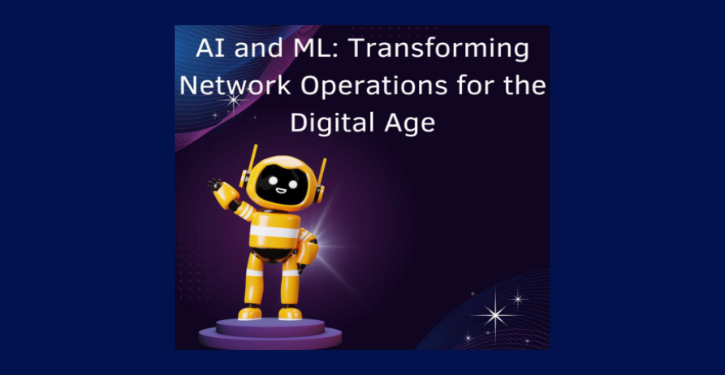AI and ML: Transforming Network Operations for the Digital Age

This article delves into the transformative impact of Artificial Intelligence (AI) and Machine Learning (ML) on Network Operations Centers (NOCs), showcasing how these technologies enhance network efficiency, security, and proactive management. Network infrastructure expert Ravi Theja Kambhampati explores their critical role in revolutionizing modern network operations.
From Reactive to Proactive: The Role of AI and ML in Network Operations
Once centered on manual monitoring and reactive troubleshooting, NOCs are transforming into proactive, intelligent hubs through AI and ML integration. Predictive analytics enables NOCs to analyze historical and real-time data, forecasting potential issues and allowing preemptive interventions. This approach reduces downtime, boosts reliability, and resolves issues before impacting performance.
Pattern Recognition and Anomaly Detection: Bolstering Network Security
AI and ML play a crucial role in identifying network anomalies by analyzing patterns across extensive data. ML algorithms establish baseline behaviors, enabling NOCs to detect deviations that signal security threats or operational issues, enhancing security, efficiency, and enabling faster responses beyond traditional methods.
Automated Root Cause Analysis: Faster Troubleshooting
AI-powered root cause analysis significantly cuts troubleshooting time by rapidly scanning logs and network events to identify issues. This automation speeds up responses, reducing disruptions and improving user experience. In complex networks, it simplifies diagnostics, allowing NOC personnel to focus on strategic, high-value tasks.
Intelligent Traffic Management and Load Balancing
AI significantly improves NOC capabilities in traffic management and load balancing. Through real-time analysis, AI predicts congestion and dynamically adjusts resources, ensuring optimal performance and smooth user experiences under high traffic. This adaptability is vital for maintaining stability in today’s data-intensive environments.
Streamlining Operations with Routine Task Automation
AI and ML streamline operations by automating tasks like configuration management, software updates, and troubleshooting, reducing human error and boosting efficiency. This allows NOC teams to focus on strategic work, while consistent automation enhances network stability, lowers costs, and improves overall management efficiency.
Enhanced Monitoring and Detection: The Power of Real-Time Analysis
AI-powered NOCs revolutionize network monitoring by analyzing real-time data streams, providing continuous insights on network health, traffic, and resource utilization. With heightened accuracy, AI detects subtle threats and performance issues often overlooked, enabling NOC teams to respond quickly and maintain secure, efficient operations.
Boosting Operational Efficiency Through Reduced Mean Time to Repair (MTTR)
A major benefit of AI-enhanced NOCs is the reduction in Mean Time to Repair (MTTR). By automating diagnostics and providing targeted solutions, AI enables NOC teams to respond quickly to incidents, minimizing downtime. This efficiency boost allows handling more incidents, improving overall operations and reducing service interruptions.
Proactive Maintenance and Optimal Resource Utilization
AI and ML empower NOCs to move from reactive to proactive maintenance, predicting issues through historical and real-time data. By dynamically adjusting bandwidth, processing, and storage, AI reduces unplanned downtime, prevents over-provisioning, and lowers infrastructure costs through optimized resource allocation and scheduled maintenance.
Shaping NOC Operations and Elevating Personnel Roles
AI and ML integration transforms NOC operations, shifting human roles from repetitive tasks to strategic functions. As AI handles routine monitoring, operators can focus on complex areas like network optimization and customer management. This change minimizes errors and fosters career growth by enhancing data analysis and strategic planning skills.
Addressing Implementation Challenges and Security Concerns
AI-enhanced NOCs bring significant advantages but face challenges in implementation, such as legacy integration, data privacy, and security concerns. To address these, organizations should focus on quality data collection, equip personnel to interpret AI insights, and establish strong data governance to safeguard sensitive information.
Future Prospects: AI and ML in the Evolving Digital Landscape
The future of AI and ML in network operations holds immense potential. Advanced predictive modeling allows AI to forecast network behavior, enabling proactive optimization. Integrating with 5G and IoT will expand NOC capabilities, facilitating dynamic spectrum allocation, automated network slicing, and efficient resource management. As infrastructures grow, NOCs will evolve into proactive hubs of network intelligence.
In conclusion, Ravi Theja Kambhampati underscores AI and ML’s transformative impact on Network Operations Centers, revolutionizing network management. Despite challenges, the benefits—greater efficiency, security, and intelligence—are clear. As networks expand, AI-driven NOCs will be essential for secure, seamless, and innovative connectivity.





